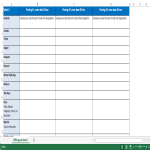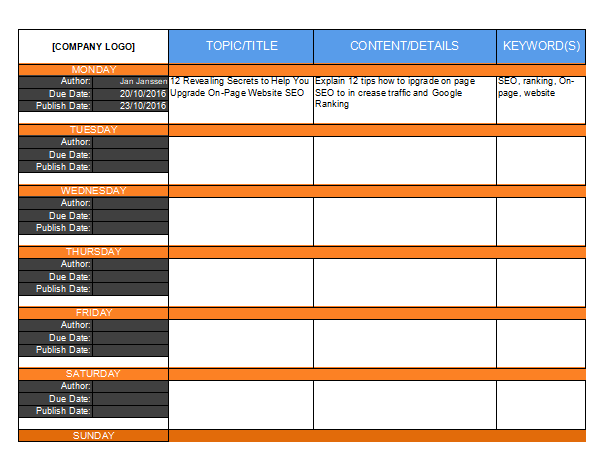Content Marketing Editorial Template
Save, fill-In The Blanks, Print, Done!

Download Content Marketing Editorial Template
Microsoft Spreadsheet (.xlsx)- This Document Has Been Certified by a Professional
- 100% customizable
- This is a digital download (30.73 kB)
- Language: English
- We recommend downloading this file onto your computer.
What are the key components and purposes of a Content Marketing Editorial? Are you looking for a Content Marketing Editorial Template? This template will help you create a content plan that is tailored to your audience's needs and interests. It will also help you ensure that you're creating content that is consistent and relevant. This editorial template will help you do exactly that!
A Content Marketing Editorial, often referred to as a Content Editorial Calendar or simply an Editorial Calendar, is a strategic planning document used by content marketers and content teams to organize, schedule, and manage their content creation and distribution efforts over a specified period, typically a month or a year. It serves as a roadmap for content creation, ensuring that content aligns with marketing goals, target audience needs, and the overall content strategy.
Here are the key components and purposes of a Content Marketing Editorial:
- Content Topics and Themes: The editorial calendar outlines the topics or themes that the content will cover. These topics should align with the brand's messaging, target audience interests, and marketing objectives.
- Publication Schedule: It specifies the dates and times when content pieces, such as blog posts, videos, social media updates, or email newsletters, will be published or distributed. A publication schedule helps maintain consistency and regularity in content delivery.
- Content Formats: The calendar indicates the type of content to be created, such as blog articles, infographics, videos, podcasts, webinars, or social media posts. Diversifying content formats helps reach a wider audience and keeps the content strategy fresh.
- Assigned Responsibilities: It assigns roles and responsibilities to team members or contributors involved in content creation. This includes writers, editors, designers, and any other individuals responsible for producing and reviewing content.
- Keywords and SEO: If applicable, the calendar may include keywords or SEO strategies to optimize content for search engines, improving its discoverability by the target audience.
- Promotion and Distribution: It outlines the channels and tactics for promoting and distributing content. This can include social media platforms, email marketing, guest posting, content syndication, and more.
- Content Objectives: Each content piece should have clear objectives, such as lead generation, brand awareness, customer education, or driving website traffic. The calendar can specify these goals for each content item.
- Audience Segmentation: Content marketing often targets different audience segments. The calendar may indicate which content pieces are intended for specific segments and how they address their unique needs or pain points.
- Content Creation Deadlines: It establishes deadlines for content creation, review, and finalization to ensure that content is ready for publication according to the schedule.
- Performance Metrics: The calendar may include placeholders for tracking key performance metrics, such as website traffic, engagement metrics, conversion rates, and social media analytics. This data helps assess the effectiveness of the content strategy.
- Content Repurposing: It may identify opportunities for repurposing existing content into different formats or for different channels to maximize content efficiency.
Content marketing editorials are essential tools for maintaining consistency, aligning content with strategic goals, and efficiently managing the content creation process within a marketing team. They provide a visual overview of content planning and help teams stay organized, measure results, and adapt their strategies as needed to achieve their marketing objectives.
According to independent research, currently, 90% of all marketers are using an editorial calendar to optimise their marketing departing and keep track of results.
Take action and download this Content Marketing Editorial Template template in Excel now!
DISCLAIMER
Nothing on this site shall be considered legal advice and no attorney-client relationship is established.
Leave a Reply. If you have any questions or remarks, feel free to post them below.
10 Excel Marketing Templates
Are you still feeling that you are struggling with spreadsheets in Excel or Google Sheets? These free Microsoft Excel and Google sheets templates can help.
Read moreRelated templates
Latest templates
Latest topics
- Excel Templates
Where do I find templates for Excel? How do I create a template in Excel? Check these editable and printable Excel Templates and download them directly! - GDPR Compliance Templates
What do you need to become GDPR compliant? Are you looking for useful GDPR document templates to make you compliant? All these compliance documents will be available to download instantly... - Google Docs Templates
How to create documents in Google Docs? We provide Google Docs compatible template and these are the reasons why it's useful to work with Google Docs... - IT Security Standards Kit
What are IT Security Standards? Check out our collection of this newly updated IT Security Kit Standard templates, including policies, controls, processes, checklists, procedures and other documents. - Letter Format
How to format a letter? Here is a brief overview of common letter formats and templates in USA and UK and get inspirited immediately!
cheese




